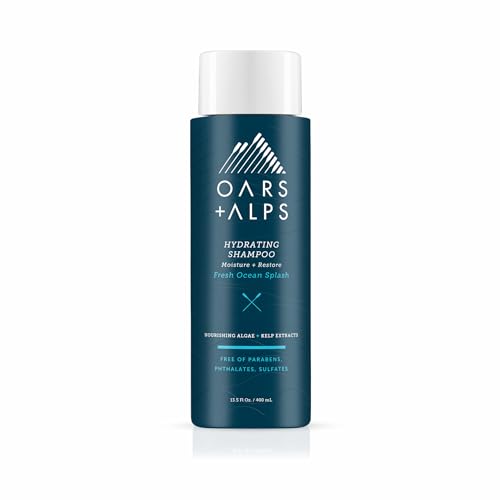
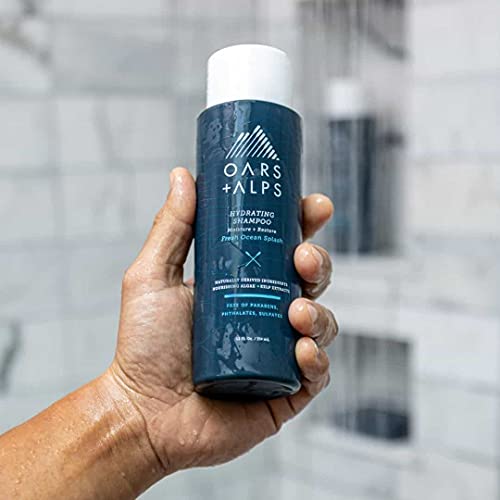
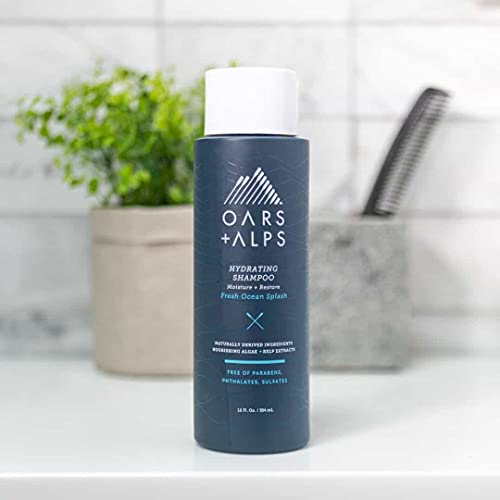
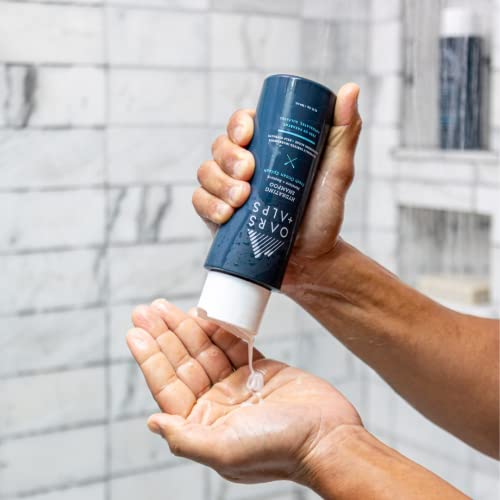
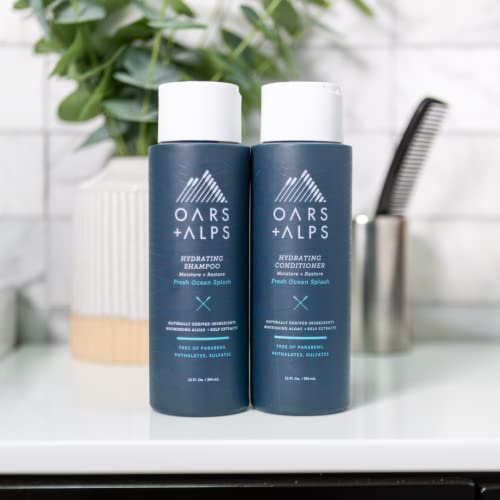
Oars + Alps Hydrating Shampoo - Moisture-Rich Formula with Kelp & Algae Extracts - 13.5oz


Cocamidopropyl Betaine
High RiskCocamidopropyl betaine is a synthetic surfactant derived from coconut oil, commonly used in personal care products for its mild cleansing and foaming properties. It functions as a surfactant, emulsifier, and thickening agent, contributing to the texture and performance of formulations.
Sustai Insights
Cocamidopropyl betaine offers functional benefits as a gentle surfactant, enhancing product foaming and texture. However, it may pose low to moderate allergenic risks and is subject to high use restrictions due to contamination concerns. Regulatory bodies have advised on its safe levels of usage, categorizing its risk level as high overall. Users should practice caution, particularly with sensitive populations, and consider alternatives like naturally derived surfactants for safer formulations.
Fragrance
High RiskFragrance refers to a mixture of aromatic compounds used in products to provide scent. It is commonly listed as 'fragrance' or 'parfum' on product labels and can serve various functions, including enhancing user experience and masking undesirable odors.
Sustai Insights
Fragrance offers functional benefits by improving product appeal; however, it poses significant health risks, notably a high likelihood of causing allergies and allergic contact dermatitis. Environmental risks include potential pollution and endocrine disruption, though its overall carcinogenicity is low. Regulatory bodies have noted concerns regarding its use, leading to a high-risk classification. Safe usage practices should be observed, and alternatives such as natural essential oils are recommended for those sensitive to synthetic fragrances.
Ascophyllum Nodosum (Knotted Wrack) Extract
Medium RiskAscophyllum nodosum extract is derived from the knotted wrack seaweed, commonly used in skincare and cosmetic products for its potential moisturizing and nutrient-rich properties. It serves as a natural ingredient that may contribute to product efficacy.
Sustai Insights
Ascophyllum nodosum extract offers functional benefits, such as hydration and nutrient delivery, while being biodegradable and sustainably sourced. Health risks appear low, with minimal concerns regarding carcinogenicity, allergies, or reproductive toxicity; however, contamination concerns have been noted. Environmental risks are considered moderate due to potential pollutants. Regulatory restrictions apply to certain verified products, leading to an overall medium risk assessment. Safe usage practices recommend avoiding excessive exposure, and alternatives include other seaweed extracts known for similar benefits.
Laminaria Digitata Extract
Medium RiskLaminaria digitata extract is an extract derived from the brown seaweed Laminaria digitata, commonly used in cosmetic formulations for its potential skin benefits and as a natural source of minerals and vitamins.
Sustai Insights
Laminaria digitata extract offers functional benefits such as moisturizing and antioxidant properties, making it useful in skin care products. It is generally recognized as having a low risk for cancer, allergies, or reproductive toxicity. However, contamination concerns have been noted, necessitating careful sourcing. Regulatory bodies have not imposed significant restrictions, suggesting an overall medium risk level. Safe usage practices should be observed, and alternatives like other seaweed extracts could be considered for sustainability.
Citric Acid
Medium RiskCitric acid is an alpha hydroxy acid used in personal care products primarily for its role as a pH adjuster and natural preservative. It occurs naturally in citrus fruits and is commonly utilized in various formulations for its chelating properties and mild exfoliation benefits.
Sustai Insights
Citric acid offers functional benefits as an effective preservative and pH stabilizer, contributing to product longevity and stability. It is biodegradable and derived from renewable sources. Health risks are low, with minimal concerns regarding carcinogenicity, allergies, and reproductive toxicity. However, moderate use restrictions exist due to potential irritation at high concentrations. Environmental risks are limited, as citric acid is not known to accumulate in ecosystems. Regulatory agencies have no significant advisories against its use. Overall, it is assessed as a medium-risk ingredient, with safe usage practices recommended and alternatives available.
Sodium Benzoate
Medium RiskSodium benzoate is a preservative commonly used in food and cosmetic products to prevent microbial growth and extend shelf life. It is derived from benzoic acid and is effective at low concentrations, often used in acidic environments like beverages and condiments.
Sustai Insights
Sodium benzoate serves effectively as a preservative, contributing to product stability and safety. It is generally recognized as safe with low concerns for carcinogenicity, allergies, and reproductive toxicity, though it faces moderate use restrictions in some regions. Environmental risks include its potential as a pollutant, but it does not bioaccumulate significantly. Regulatory bodies have issued advisories regarding its concentration in products. Overall, the risk level is assessed as medium, with safe usage practices recommended. Alternatives such as potassium sorbate may provide similar benefits with potentially lower restrictions.
Potassium Sorbate
Medium RiskPotassium sorbate is a potassium salt of sorbic acid, primarily used as a preservative in food and cosmetic products. It inhibits the growth of molds, yeast, and some bacteria, extending the shelf life of products. It is commonly found in various formulations due to its effectiveness and low toxicity.
Sustai Insights
Potassium sorbate serves as an effective preservative, preventing microbial growth in food and cosmetic products, which is vital for safety and longevity. Although it has a low risk of carcinogenicity and developmental toxicity, there is a moderate concern regarding allergies and immunotoxicity. Environmentally, it poses minimal risks as it is not significantly bioaccumulative. Regulatory agencies have verified its use, although some products may face restrictions. Overall, it is assessed as a medium risk ingredient, with safe usage practices recommended, and alternatives such as natural preservatives could be considered.
Sorbeth 230 Tetraoleate
Low RiskSorbeth 230 tetraoleate is a nonionic surfactant commonly used in cosmetic formulations as an emulsifier and stabilizer. It aids in blending oil and water components, enhancing texture and consistency in various products.
Sustai Insights
Sorbeth 230 tetraoleate provides effective emulsification, improving product stability and texture. Its risk profile indicates low concerns regarding carcinogenicity, allergies, and reproductive toxicity, although contamination risks are noted. Regulatory assessments show no significant restrictions. Environmental impacts appear minimal, with low bioaccumulation potential. Safe usage practices should be observed, and while no direct alternatives are specified, evaluating greener emulsifiers may be beneficial. Overall, the ingredient is assessed as low risk.
Cocamide Mipa
Low RiskCocamide MIPA is a mixture of isopropanolamide derived from coconut fatty acids. It serves primarily as a surfactant and emulsifying agent in cosmetic formulations, contributing to the texture and stability of products such as shampoos and cleansers.
Sustai Insights
Cocamide MIPA offers functional benefits as a surfactant, enhancing product performance and texture. It is considered low risk for health concerns, with minimal irritation potential, and low environmental impact. Regulatory bodies have not imposed significant restrictions, indicating a favorable safety profile. Safe usage practices should be followed, and while alternatives exist, Cocamide MIPA's overall risk assessment remains low.
Cocamidopropyl Hydroxysultaine
Low RiskCocamidopropyl hydroxysultaine is a synthetic skin and hair conditioning agent commonly used in personal care products. It functions primarily as a surfactant, providing foaming and emulsifying properties, while also contributing to the conditioning of hair and skin.
Sustai Insights
Cocamidopropyl hydroxysultaine offers functional benefits as a mild surfactant and conditioning agent, with low concerns regarding carcinogenicity, allergies, and reproductive toxicity. It is generally regarded as safe with low irritation potential. Environmental assessments indicate low pollutant potential and minimal bioaccumulation. Regulatory bodies have not imposed significant restrictions on its use, aligning with low risk levels overall. Safe usage is advised, particularly for sensitive populations, and alternative gentle surfactants may be considered for those seeking greener options. In conclusion, this ingredient is classified as low risk.
Erythritol
Low RiskErythritol is a sugar alcohol used primarily as a low-calorie sweetener in various food and beverage products. It occurs naturally in some fruits and fermented foods. Erythritol provides sweetness without significant calories or raising blood glucose levels, making it a popular alternative to traditional sugars.
Sustai Insights
Erythritol offers functional benefits as a sweetener with low caloric content, providing a suitable option for sugar reduction. It is considered safe with low concerns regarding carcinogenicity, allergies, and reproductive toxicity. Environmentally, it is not recognized as a significant pollutant nor does it bioaccumulate. Regulatory status is favorable, with no current restrictions. Overall, the ingredient presents a low risk, making it a viable option for consumers seeking healthier alternatives.
Sodium Cocoyl Glutamate
Low RiskSodium cocoyl glutamate is a sodium salt of glutamic acid, derived from coconut oil. It serves primarily as a surfactant and mild cleansing agent in cosmetic formulations, contributing to the product's ability to remove dirt and oil while being gentle on the skin.
Sustai Insights
Sodium cocoyl glutamate offers functional benefits as a surfactant, enhancing cleansing efficacy without excessive irritation. It is considered low risk regarding health concerns, including carcinogenicity and allergenic potential. Regulatory assessments indicate no significant environmental hazards or restrictions. Overall, it is a low-risk ingredient, suitable for use in personal care products, with no notable adverse effects or regulatory warnings.
Polyquaternium 73
Low RiskPolyquaternium-73 is a synthetic polymer commonly used in cosmetic formulations as a conditioning agent and film-former. It enhances the texture and feel of hair and skin products, providing a smooth finish and improved manageability. Its functions include reducing static and enhancing moisture retention.
Sustai Insights
Polyquaternium-73 offers effective conditioning benefits, improving the performance of cosmetic products. It is regarded as low risk for cancer, allergies, and developmental toxicity, with no significant environmental hazard reported. Regulatory bodies have not flagged it for restriction. Safe usage practices should be followed, and while alternatives exist, they may not provide the same functional benefits. Overall, the assessment indicates a low risk associated with this ingredient.
Water
Low RiskWater is a clear, colorless liquid essential for various biological processes. It serves as a solvent in formulations, facilitating the dissolution of other ingredients and enhancing product texture and application. Additionally, water plays a crucial role in hydration and is a key component in many cosmetic and personal care products.
Sustai Insights
Water is an effective solvent and hydrator, contributing to the texture and efficacy of formulations. It is biodegradable and generally regarded as safe, with low concerns regarding carcinogenicity, allergies, and reproductive toxicity. However, excessive water usage can lead to environmental concerns, particularly regarding resource depletion. Regulatory bodies do not impose restrictions on water use in cosmetics. Overall, the risks associated with water are low, making it a safe and essential ingredient.
Decyl Glucoside
Low RiskDecyl glucoside is a glucose-based surfactant derived from natural sources, primarily used as a mild cleansing agent in personal care products. It effectively reduces surface tension, allowing for improved mixing of ingredients and enhanced cleansing properties without stripping natural oils from the skin.
Sustai Insights
Decyl glucoside offers functional benefits as a non-ionic surfactant, making it suitable for sensitive skin formulations. It is biodegradable and derived from renewable resources, supporting sustainability. Health risks are primarily low, with minimal concerns regarding irritation and allergies. Environmental risks are low, as it does not significantly contribute to pollution or bioaccumulation. Regulatory status is generally favorable, with low restrictions noted. Overall, decyl glucoside presents a low risk for use in consumer products, making it a suitable choice for gentle formulations.
Sorbitan Laurate
Low RiskSorbitan laurate is a monoester of lauric acid and sorbitol. It is commonly used as an emulsifier and surfactant in cosmetic formulations, aiding in the mixing of oil and water components, and enhancing the texture and stability of products.
Sustai Insights
Sorbitan laurate effectively functions as an emulsifier, stabilizing formulations and improving texture. It is considered low risk for health concerns such as cancer, allergies, and reproductive toxicity, with no current restrictions from regulatory bodies. Environmentally, it poses minimal hazards, as it is not bioaccumulative or a significant pollutant. Safe usage practices should be followed, and while there are alternatives, sorbitan laurate remains a low-risk option in cosmetic applications.
Glycol Stearate
Low RiskGlycol stearate is composed of ethylene glycol and stearic acid. It serves primarily as an emulsifier and thickener in cosmetic formulations, helping to stabilize and enhance the texture of products.
Sustai Insights
Glycol stearate exhibits functional benefits as an effective emulsifier, improving product stability and texture. It is generally recognized as having low health risks, with no significant concerns regarding carcinogenicity, allergies, or reproductive toxicity. Environmentally, it poses low risks with no significant pollutant potential or bioaccumulation. Regulatory agencies have not imposed significant restrictions on its use in cosmetics. Overall, it is assessed as low risk, making it a suitable ingredient in formulations. For those seeking alternatives, other natural emulsifiers may be considered.
Vegetarian Glycerin
Low RiskVegetarian glycerin, also known as glycerol, is a colorless, odorless, and viscous liquid derived from plant sources. It is primarily used as a humectant, solvent, and emollient in various personal care products, helping to retain moisture and improve texture.
Sustai Insights
Vegetarian glycerin offers functional benefits as an effective humectant, promoting hydration and skin smoothness. It is biodegradable and typically sustainably sourced. Health risks associated with glycerin are low, with no significant concerns for carcinogenicity, allergens, or reproductive toxicity. Environmental risks are minimal, and it is not subject to major regulatory warnings. Overall, the risk level for this ingredient is low, making it a safe choice in formulations. Safe usage practices include ensuring proper concentrations in products, and alternatives such as propylene glycol exist but may have differing properties.
Sodium Gluconate
Low RiskSodium gluconate is a sodium salt of gluconic acid, commonly used as a chelating agent in various personal care products. It functions primarily to bind metal ions, enhancing product stability and efficacy. Additionally, it may serve as a moisturizer and skin conditioning agent.
Sustai Insights
Sodium gluconate is valued for its functional benefits, including effective chelation and moisture retention, contributing positively to product performance. It is considered low risk concerning health impacts, with minimal concerns regarding carcinogenicity, allergies, or reproductive toxicity. Environmental assessments indicate low pollutant potential and minimal bioaccumulation. Regulatory bodies have not imposed significant restrictions. Safe usage practices are advised, particularly regarding enhanced skin absorption. Overall, sodium gluconate presents a low risk profile, making it a viable choice in personal care formulations.
Ascophyllum Nodosum (Knotted Wrack) Extract
Medium RiskAscophyllum nodosum extract is derived from the knotted wrack seaweed, commonly used in skincare and cosmetic products for its potential moisturizing and nutrient-rich properties. It serves as a natural ingredient that may contribute to product efficacy.
Sustai Insights
Ascophyllum nodosum extract offers functional benefits, such as hydration and nutrient delivery, while being biodegradable and sustainably sourced. Health risks appear low, with minimal concerns regarding carcinogenicity, allergies, or reproductive toxicity; however, contamination concerns have been noted. Environmental risks are considered moderate due to potential pollutants. Regulatory restrictions apply to certain verified products, leading to an overall medium risk assessment. Safe usage practices recommend avoiding excessive exposure, and alternatives include other seaweed extracts known for similar benefits.
Sorbeth 230 Tetraoleate
Low RiskSorbeth 230 tetraoleate is a nonionic surfactant commonly used in cosmetic formulations as an emulsifier and stabilizer. It aids in blending oil and water components, enhancing texture and consistency in various products.
Sustai Insights
Sorbeth 230 tetraoleate provides effective emulsification, improving product stability and texture. Its risk profile indicates low concerns regarding carcinogenicity, allergies, and reproductive toxicity, although contamination risks are noted. Regulatory assessments show no significant restrictions. Environmental impacts appear minimal, with low bioaccumulation potential. Safe usage practices should be observed, and while no direct alternatives are specified, evaluating greener emulsifiers may be beneficial. Overall, the ingredient is assessed as low risk.
Laminaria Digitata Extract
Medium RiskLaminaria digitata extract is an extract derived from the brown seaweed Laminaria digitata, commonly used in cosmetic formulations for its potential skin benefits and as a natural source of minerals and vitamins.
Sustai Insights
Laminaria digitata extract offers functional benefits such as moisturizing and antioxidant properties, making it useful in skin care products. It is generally recognized as having a low risk for cancer, allergies, or reproductive toxicity. However, contamination concerns have been noted, necessitating careful sourcing. Regulatory bodies have not imposed significant restrictions, suggesting an overall medium risk level. Safe usage practices should be observed, and alternatives like other seaweed extracts could be considered for sustainability.
Cocamide Mipa
Low RiskCocamide MIPA is a mixture of isopropanolamide derived from coconut fatty acids. It serves primarily as a surfactant and emulsifying agent in cosmetic formulations, contributing to the texture and stability of products such as shampoos and cleansers.
Sustai Insights
Cocamide MIPA offers functional benefits as a surfactant, enhancing product performance and texture. It is considered low risk for health concerns, with minimal irritation potential, and low environmental impact. Regulatory bodies have not imposed significant restrictions, indicating a favorable safety profile. Safe usage practices should be followed, and while alternatives exist, Cocamide MIPA's overall risk assessment remains low.
Citric Acid
Medium RiskCitric acid is an alpha hydroxy acid used in personal care products primarily for its role as a pH adjuster and natural preservative. It occurs naturally in citrus fruits and is commonly utilized in various formulations for its chelating properties and mild exfoliation benefits.
Sustai Insights
Citric acid offers functional benefits as an effective preservative and pH stabilizer, contributing to product longevity and stability. It is biodegradable and derived from renewable sources. Health risks are low, with minimal concerns regarding carcinogenicity, allergies, and reproductive toxicity. However, moderate use restrictions exist due to potential irritation at high concentrations. Environmental risks are limited, as citric acid is not known to accumulate in ecosystems. Regulatory agencies have no significant advisories against its use. Overall, it is assessed as a medium-risk ingredient, with safe usage practices recommended and alternatives available.
Cocamidopropyl Hydroxysultaine
Low RiskCocamidopropyl hydroxysultaine is a synthetic skin and hair conditioning agent commonly used in personal care products. It functions primarily as a surfactant, providing foaming and emulsifying properties, while also contributing to the conditioning of hair and skin.
Sustai Insights
Cocamidopropyl hydroxysultaine offers functional benefits as a mild surfactant and conditioning agent, with low concerns regarding carcinogenicity, allergies, and reproductive toxicity. It is generally regarded as safe with low irritation potential. Environmental assessments indicate low pollutant potential and minimal bioaccumulation. Regulatory bodies have not imposed significant restrictions on its use, aligning with low risk levels overall. Safe usage is advised, particularly for sensitive populations, and alternative gentle surfactants may be considered for those seeking greener options. In conclusion, this ingredient is classified as low risk.
Sodium Benzoate
Medium RiskSodium benzoate is a preservative commonly used in food and cosmetic products to prevent microbial growth and extend shelf life. It is derived from benzoic acid and is effective at low concentrations, often used in acidic environments like beverages and condiments.
Sustai Insights
Sodium benzoate serves effectively as a preservative, contributing to product stability and safety. It is generally recognized as safe with low concerns for carcinogenicity, allergies, and reproductive toxicity, though it faces moderate use restrictions in some regions. Environmental risks include its potential as a pollutant, but it does not bioaccumulate significantly. Regulatory bodies have issued advisories regarding its concentration in products. Overall, the risk level is assessed as medium, with safe usage practices recommended. Alternatives such as potassium sorbate may provide similar benefits with potentially lower restrictions.
Erythritol
Low RiskErythritol is a sugar alcohol used primarily as a low-calorie sweetener in various food and beverage products. It occurs naturally in some fruits and fermented foods. Erythritol provides sweetness without significant calories or raising blood glucose levels, making it a popular alternative to traditional sugars.
Sustai Insights
Erythritol offers functional benefits as a sweetener with low caloric content, providing a suitable option for sugar reduction. It is considered safe with low concerns regarding carcinogenicity, allergies, and reproductive toxicity. Environmentally, it is not recognized as a significant pollutant nor does it bioaccumulate. Regulatory status is favorable, with no current restrictions. Overall, the ingredient presents a low risk, making it a viable option for consumers seeking healthier alternatives.
Potassium Sorbate
Medium RiskPotassium sorbate is a potassium salt of sorbic acid, primarily used as a preservative in food and cosmetic products. It inhibits the growth of molds, yeast, and some bacteria, extending the shelf life of products. It is commonly found in various formulations due to its effectiveness and low toxicity.
Sustai Insights
Potassium sorbate serves as an effective preservative, preventing microbial growth in food and cosmetic products, which is vital for safety and longevity. Although it has a low risk of carcinogenicity and developmental toxicity, there is a moderate concern regarding allergies and immunotoxicity. Environmentally, it poses minimal risks as it is not significantly bioaccumulative. Regulatory agencies have verified its use, although some products may face restrictions. Overall, it is assessed as a medium risk ingredient, with safe usage practices recommended, and alternatives such as natural preservatives could be considered.
Sodium Cocoyl Glutamate
Low RiskSodium cocoyl glutamate is a sodium salt of glutamic acid, derived from coconut oil. It serves primarily as a surfactant and mild cleansing agent in cosmetic formulations, contributing to the product's ability to remove dirt and oil while being gentle on the skin.
Sustai Insights
Sodium cocoyl glutamate offers functional benefits as a surfactant, enhancing cleansing efficacy without excessive irritation. It is considered low risk regarding health concerns, including carcinogenicity and allergenic potential. Regulatory assessments indicate no significant environmental hazards or restrictions. Overall, it is a low-risk ingredient, suitable for use in personal care products, with no notable adverse effects or regulatory warnings.
Polyquaternium 73
Low RiskPolyquaternium-73 is a synthetic polymer commonly used in cosmetic formulations as a conditioning agent and film-former. It enhances the texture and feel of hair and skin products, providing a smooth finish and improved manageability. Its functions include reducing static and enhancing moisture retention.
Sustai Insights
Polyquaternium-73 offers effective conditioning benefits, improving the performance of cosmetic products. It is regarded as low risk for cancer, allergies, and developmental toxicity, with no significant environmental hazard reported. Regulatory bodies have not flagged it for restriction. Safe usage practices should be followed, and while alternatives exist, they may not provide the same functional benefits. Overall, the assessment indicates a low risk associated with this ingredient.
Water
Low RiskWater is a clear, colorless liquid essential for various biological processes. It serves as a solvent in formulations, facilitating the dissolution of other ingredients and enhancing product texture and application. Additionally, water plays a crucial role in hydration and is a key component in many cosmetic and personal care products.
Sustai Insights
Water is an effective solvent and hydrator, contributing to the texture and efficacy of formulations. It is biodegradable and generally regarded as safe, with low concerns regarding carcinogenicity, allergies, and reproductive toxicity. However, excessive water usage can lead to environmental concerns, particularly regarding resource depletion. Regulatory bodies do not impose restrictions on water use in cosmetics. Overall, the risks associated with water are low, making it a safe and essential ingredient.
Decyl Glucoside
Low RiskDecyl glucoside is a glucose-based surfactant derived from natural sources, primarily used as a mild cleansing agent in personal care products. It effectively reduces surface tension, allowing for improved mixing of ingredients and enhanced cleansing properties without stripping natural oils from the skin.
Sustai Insights
Decyl glucoside offers functional benefits as a non-ionic surfactant, making it suitable for sensitive skin formulations. It is biodegradable and derived from renewable resources, supporting sustainability. Health risks are primarily low, with minimal concerns regarding irritation and allergies. Environmental risks are low, as it does not significantly contribute to pollution or bioaccumulation. Regulatory status is generally favorable, with low restrictions noted. Overall, decyl glucoside presents a low risk for use in consumer products, making it a suitable choice for gentle formulations.
Sorbitan Laurate
Low RiskSorbitan laurate is a monoester of lauric acid and sorbitol. It is commonly used as an emulsifier and surfactant in cosmetic formulations, aiding in the mixing of oil and water components, and enhancing the texture and stability of products.
Sustai Insights
Sorbitan laurate effectively functions as an emulsifier, stabilizing formulations and improving texture. It is considered low risk for health concerns such as cancer, allergies, and reproductive toxicity, with no current restrictions from regulatory bodies. Environmentally, it poses minimal hazards, as it is not bioaccumulative or a significant pollutant. Safe usage practices should be followed, and while there are alternatives, sorbitan laurate remains a low-risk option in cosmetic applications.
Glycol Stearate
Low RiskGlycol stearate is composed of ethylene glycol and stearic acid. It serves primarily as an emulsifier and thickener in cosmetic formulations, helping to stabilize and enhance the texture of products.
Sustai Insights
Glycol stearate exhibits functional benefits as an effective emulsifier, improving product stability and texture. It is generally recognized as having low health risks, with no significant concerns regarding carcinogenicity, allergies, or reproductive toxicity. Environmentally, it poses low risks with no significant pollutant potential or bioaccumulation. Regulatory agencies have not imposed significant restrictions on its use in cosmetics. Overall, it is assessed as low risk, making it a suitable ingredient in formulations. For those seeking alternatives, other natural emulsifiers may be considered.
Cocamidopropyl Betaine
High RiskCocamidopropyl betaine is a synthetic surfactant derived from coconut oil, commonly used in personal care products for its mild cleansing and foaming properties. It functions as a surfactant, emulsifier, and thickening agent, contributing to the texture and performance of formulations.
Sustai Insights
Cocamidopropyl betaine offers functional benefits as a gentle surfactant, enhancing product foaming and texture. However, it may pose low to moderate allergenic risks and is subject to high use restrictions due to contamination concerns. Regulatory bodies have advised on its safe levels of usage, categorizing its risk level as high overall. Users should practice caution, particularly with sensitive populations, and consider alternatives like naturally derived surfactants for safer formulations.
Vegetarian Glycerin
Low RiskVegetarian glycerin, also known as glycerol, is a colorless, odorless, and viscous liquid derived from plant sources. It is primarily used as a humectant, solvent, and emollient in various personal care products, helping to retain moisture and improve texture.
Sustai Insights
Vegetarian glycerin offers functional benefits as an effective humectant, promoting hydration and skin smoothness. It is biodegradable and typically sustainably sourced. Health risks associated with glycerin are low, with no significant concerns for carcinogenicity, allergens, or reproductive toxicity. Environmental risks are minimal, and it is not subject to major regulatory warnings. Overall, the risk level for this ingredient is low, making it a safe choice in formulations. Safe usage practices include ensuring proper concentrations in products, and alternatives such as propylene glycol exist but may have differing properties.
Fragrance
High RiskFragrance refers to a mixture of aromatic compounds used in products to provide scent. It is commonly listed as 'fragrance' or 'parfum' on product labels and can serve various functions, including enhancing user experience and masking undesirable odors.
Sustai Insights
Fragrance offers functional benefits by improving product appeal; however, it poses significant health risks, notably a high likelihood of causing allergies and allergic contact dermatitis. Environmental risks include potential pollution and endocrine disruption, though its overall carcinogenicity is low. Regulatory bodies have noted concerns regarding its use, leading to a high-risk classification. Safe usage practices should be observed, and alternatives such as natural essential oils are recommended for those sensitive to synthetic fragrances.
Sodium Gluconate
Low RiskSodium gluconate is a sodium salt of gluconic acid, commonly used as a chelating agent in various personal care products. It functions primarily to bind metal ions, enhancing product stability and efficacy. Additionally, it may serve as a moisturizer and skin conditioning agent.
Sustai Insights
Sodium gluconate is valued for its functional benefits, including effective chelation and moisture retention, contributing positively to product performance. It is considered low risk concerning health impacts, with minimal concerns regarding carcinogenicity, allergies, or reproductive toxicity. Environmental assessments indicate low pollutant potential and minimal bioaccumulation. Regulatory bodies have not imposed significant restrictions. Safe usage practices are advised, particularly regarding enhanced skin absorption. Overall, sodium gluconate presents a low risk profile, making it a viable choice in personal care formulations.
Transform your hair care routine with Oars + Alps Hydrating Shampoo. Designed to combat dryness, static, and frizz, this shampoo nourishes your hair while providing a gentle cleanse without harsh chemicals.
- Hydrating Formula: Promotes smoother, healthier hair with every wash.
- Sulfate-Free: Cleansing agents derived from coconut, palm, and beets.
- Nutrient-Rich: Kelp and algae extracts support healthy hair growth.
- Moisture Retention: Algae extract helps maintain hydration levels.
- Strengthening Ingredients: Creatine rebuilds and fortifies hair structure.
- Gentle Cleanse: Creamy lather cleans effectively without stripping oils.
- Safe for All: Alcohol-free, paraben-free, and phthalate-free formula.
Subscribe & Save with Sustai
- Best Price Guarantee: Always enjoy the lowest prices on sustainable home essentials.
- No Surprises: We’ll notify you before shipping. No hidden fees, ever.
- You’re in Charge: Change, pause, or cancel your subscription anytime with ease.
- Eco-Friendly Deliveries: Our grouped shipments mean less packaging and lower emissions.
Join us on a sustainable journey. Special offers for a limited time! Prices and promotions may change.
Recommended Products
Transform your hair care routine with Oars + Alps Hydrating Shampoo. Designed to combat dryness, static, and frizz, this shampoo nourishes your hair while providing a gentle cleanse without harsh chemicals.
- Hydrating Formula: Promotes smoother, healthier hair with every wash.
- Sulfate-Free: Cleansing agents derived from coconut, palm, and beets.
- Nutrient-Rich: Kelp and algae extracts support healthy hair growth.
- Moisture Retention: Algae extract helps maintain hydration levels.
- Strengthening Ingredients: Creatine rebuilds and fortifies hair structure.
- Gentle Cleanse: Creamy lather cleans effectively without stripping oils.
- Safe for All: Alcohol-free, paraben-free, and phthalate-free formula.

You can have at most 2 Sustainable Steals products in your cart
Customer Reviews
Customers’ View
Customers appreciate the hydrating properties of this shampoo, noting that it effectively combats dryness and frizz without harsh chemicals. Many users highlight the natural ingredients, such as kelp and algae extracts, which are perceived as beneficial for hair health. One reviewer mentions the product's pleasant scent and its chemical-free formulation, reinforcing its appeal to environmentally conscious consumers. Although some users experienced minor mix-ups with product orders, the overall sentiment is positive, emphasizing the gentle cleansing action that maintains moisture without stripping oils. Overall, customers find this shampoo to be a reliable choice that aligns well with their health-focused and eco-friendly values.
AI-generated from the text of customer reviewsThis product has no reviews yet.




